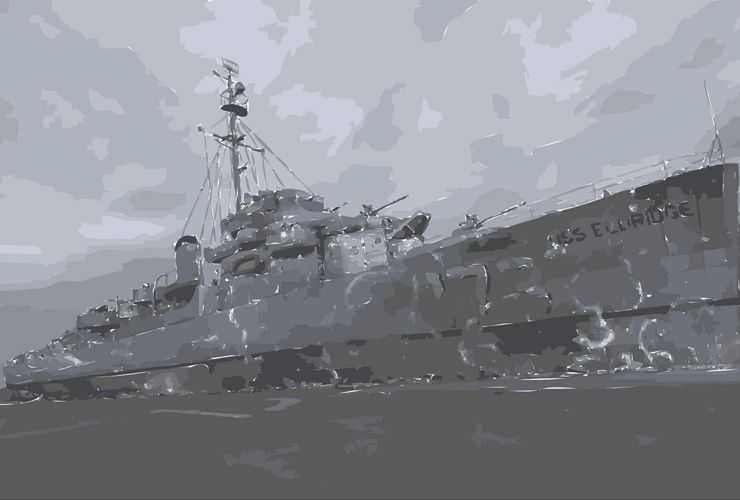“Project Cheesesteak – Where Taste Meets Time Travel!”

The Philadelphia Experiment is a long-standing conspiracy theory that alleges the United States Navy conducted a top-secret experiment in Philadelphia, Pennsylvania, during World War II. According to the conspiracy, the experiment aimed to render a U.S. Navy destroyer, the USS Eldridge (DE-173), invisible to enemy radar and even physically invisible.
The story goes like this:
In 1943, during the height of World War II, the U.S. Navy supposedly partnered with a brilliant scientist or scientists, sometimes associated with the fictional “Project Rainbow,” to explore the possibilities of invisibility and radar cloaking for ships. The project’s primary goal was to make Allied vessels invisible to enemy radar, potentially giving them a significant advantage in naval battles.
The alleged experiment took place at the Philadelphia Naval Shipyard, where the USS Eldridge was docked. The technology used in the experiment was supposedly based on concepts from Albert Einstein’s unified field theory, a theoretical attempt to combine electromagnetism and gravity into a single set of equations.
As the story goes, during the experiment, the USS Eldridge was fitted with powerful electromagnetic equipment and turned invisible, or “cloaked,” for a brief period. However, the consequences of the experiment were far more catastrophic than anticipated. Not only did the ship disappear from view, but it was also said to have teleported to another location hundreds of miles away. Additionally, there were claims that crew members suffered from severe physiological effects, such as becoming fused with the ship’s metal or suffering from mental disorders. Allegedly, the technology was further developed in secret and was used in later military projects, including those related to time travel and interdimensional travel.
The conspiracy theory first gained traction in the 1950s when Carl Allen, a man who claimed to have served on the USS Eldridge during the experiment, approached UFO researcher Morris K. Jessup with his account. Jessup published a book that included Allen’s story, but the book did not gain widespread attention at the time.
The modern popularity of the Philadelphia Experiment can be attributed to the 1979 book “The Philadelphia Experiment: Project Invisibility” by Charles Berlitz and William L. Moore, which brought the story to a wider audience. Since then, the tale has been perpetuated through various books, documentaries, and internet sources.
Ingredients:
- 1 pound (450g) thinly sliced ribeye steak or sirloin
- 4 hoagie rolls or soft Italian rolls
- 1 large onion, thinly sliced
- 1 large green bell pepper, thinly sliced
- 8 slices of provolone cheese (or Cheez Whiz for a more authentic Philly experience)
- 2 tablespoons vegetable oil or olive oil
- Salt and black pepper to taste
- Optional toppings: mushrooms, hot peppers, ketchup, or mayonnaise
Instructions:
- Prepare the rolls: If the rolls are not already split, slice them in half and set them aside.
- Heat the oil: In a large skillet or griddle over medium-high heat, add the vegetable oil.
- Cook the onions and peppers: Add the sliced onions and green bell peppers to the skillet and sauté them until they become soft and slightly caramelized. Remove them from the skillet and set them aside.
- Cook the steak: In the same skillet, add the thinly sliced ribeye or sirloin steak. Cook the meat until it’s browned and fully cooked. Season with salt and black pepper to taste.
- Add the onions and peppers back in: Once the steak is cooked, return the sautéed onions and peppers to the skillet with the meat. Mix everything together to combine the flavors.
- Cheese it up: Lay the slices of provolone cheese over the steak mixture in the skillet. You can also use Cheez Whiz, which is a popular choice in traditional Philly cheesesteaks. Cover the skillet with a lid or a sheet of aluminum foil for a minute or two until the cheese melts.
- Assemble the sandwiches: Take the hoagie rolls and fill them with the steak, onion, and pepper mixture. Use a spatula to transfer the cheesesteak filling into the rolls.
- Serve and enjoy: Your delicious Philly cheesesteaks are now ready to be served! Optionally, you can add toppings like sautéed mushrooms, hot peppers, ketchup, or mayonnaise.
Enjoy your homemade Philly cheesesteaks, and savor the mouthwatering flavors while bending time!
